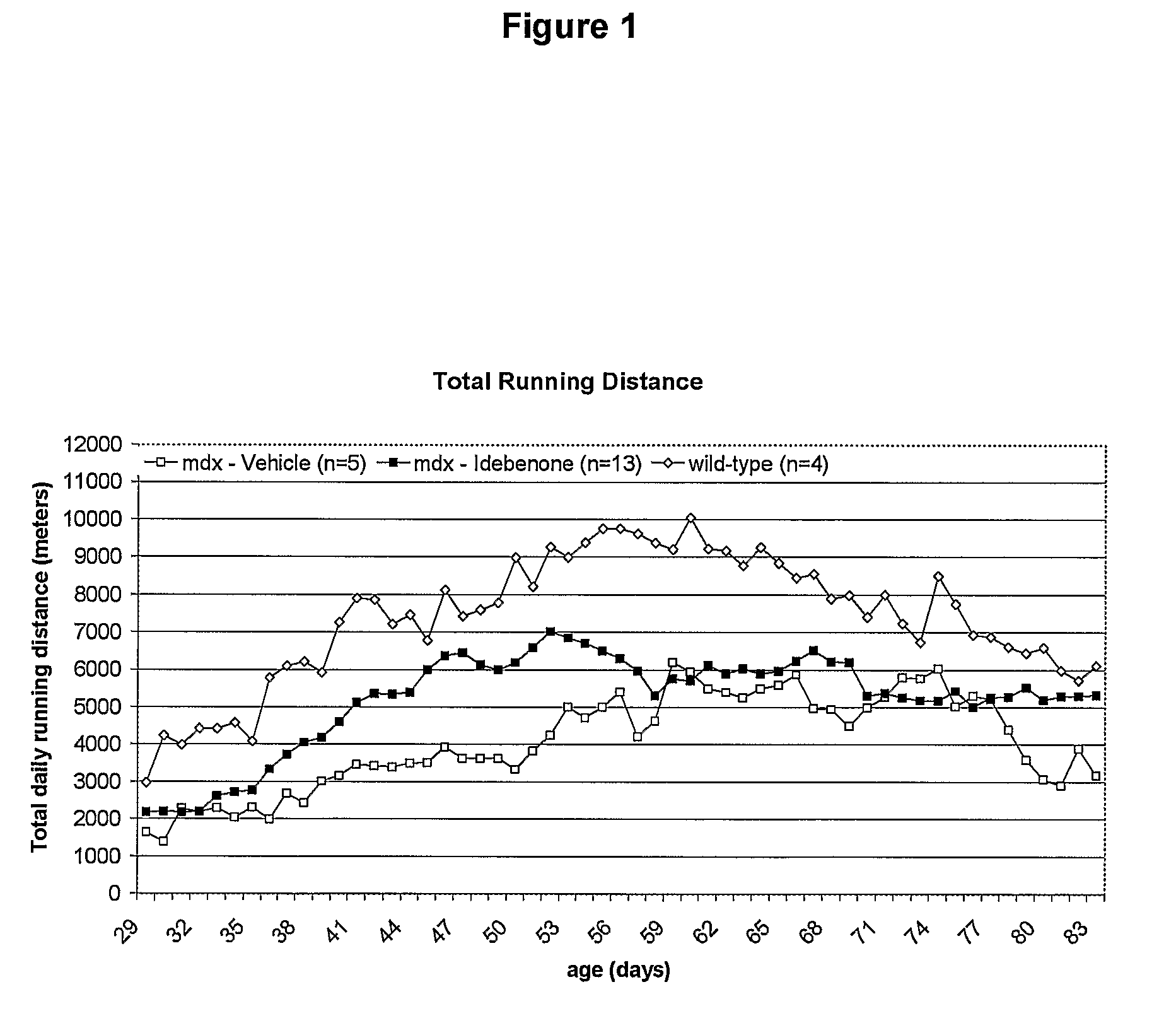Quinone Derivative 2,3-Dimethoxy-5-Methyl-6-(10-Hydroxydecyl)-1,4-Benzoquinone for the Treatment of Muscular Dystrophies
a technology of dmd/bmd and quinone, which is applied in the direction of biocide, plant growth regulator, animal husbandry, etc., can solve the problems of loss of ambulation in teenage patients, early morbidity and mortality in dmd/bmd patients, and death of dmd/bmd patients at early adulthood
- Summary
- Abstract
- Description
- Claims
- Application Information
AI Technical Summary
Benefits of technology
Problems solved by technology
Method used
Image
Examples
example 1
[0031]Idebenone improves muscle strength in muscular dystrophy (DMD) patients.
[0032]Effect of idebenone on skeletal muscle strength in DMD patients is assessed using a pediatric-focused quantitative muscle testing (QMT) system (CINRG Quantitative Measurement System, CQMS) based upon maximal voluntary isometric contraction. The CINRG QM System has been developed by and used in multiple CINRG (Cooperative International Neuromuscular Research Group) trials in DMD. A study comparing inter-rater reliability of MMT (manual muscle testing) and QMT testing in a group of 12 pediatric muscular dystrophy patients using 12 clinical evaluators from 11 international CINRG clinics, showed that QMT testing is reliable with ICC (inter-rater correlation coefficient)>0.9 for biceps and grip (Escolar et al. (2001); Clinical evaluator reliability for quantitative and manual muscle testing measures of strength in children. Muscle & Nerve 24: 787-793).
[0033]Testing is performed by a CQMS trained and exper...
example 2
[0036]Idebenone improves dilated cardiomyopathy in muscular dystrophy (DMD) patients.
[0037]Therapeutic effect of idebenone on the dilated cardiomyopathy can be detected by 2D and M-mode echocardiography and by tissue color Doppler methodology to quantify regional myocardial function (Weidemann F, Eyskens B, Sutherland G R. (2002) New ultrasound methods to quantify regional myocardial function in children with heart disease. Pediatr Cardiol, 23: 292-306). Specifically, real time 2-dimensional Color Doppler Myocardial Imaging (CDMI) data were recorded using GE Vingmed System V (Horten, Norway; 3.5 MHz) to evaluate longitudinal function from the interventricular septum, the LV lateral wall and the RV free wall using the standard apical 4-chamber view. To evaluate radial function in the LV infero-lateral wall, CDMI data are recorded from the parasternal short axis view. All data are acquired at a high frame rates of 120-250 frames / s using the narrowest image sector angle possible (usual...
example 3
Study Hypothesis
[0043]Without being bound to any theory by reducing oxidative stress and improving mitochondrial respiratory chain function, idebenone therapy improves the cardiomyopathy associated with dystrophin deficiency in DMD patients and improves skeletal muscle strength / performance.[0044]Parameters of the Treatment—inclusion: Duchenne muscular dystrophy (DMD) patients, male, age 10-16 yrs[0045]duration: 12 months, with assessments at baseline, 6 months, and 12 months.[0046]primary endpoint: cardiac function[0047]secondary endpoints: skeletal muscle strength, respiratory function, biochemical cardiac markers[0048]treatment regimen: idebenone, oral, fixed dose, using 150 mg tablets, 3×150 mg / day;
Patient Selection:
[0049]Patients age 10-16 years with confirmed diagnosis for DMD by a positive test for dystrophin gene deletion, dystrophin gene point mutation or dystrophin protein deficiency on biopsy with a clinical picture consistent of typical DMD are included in the study. Pati...
PUM
| Property | Measurement | Unit |
|---|---|---|
| molecular weight | aaaaa | aaaaa |
| weight | aaaaa | aaaaa |
| weight | aaaaa | aaaaa |
Abstract
Description
Claims
Application Information
 Login to View More
Login to View More - R&D
- Intellectual Property
- Life Sciences
- Materials
- Tech Scout
- Unparalleled Data Quality
- Higher Quality Content
- 60% Fewer Hallucinations
Browse by: Latest US Patents, China's latest patents, Technical Efficacy Thesaurus, Application Domain, Technology Topic, Popular Technical Reports.
© 2025 PatSnap. All rights reserved.Legal|Privacy policy|Modern Slavery Act Transparency Statement|Sitemap|About US| Contact US: help@patsnap.com



